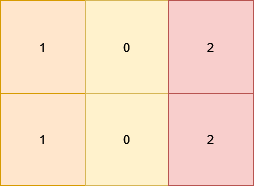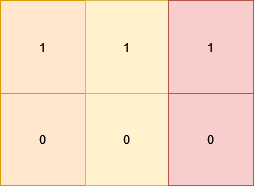3122. Minimum Number of Operations to Satisfy Conditions
3122. Minimum Number of Operations to Satisfy Conditions
Description
You are given a 2D matrix grid of size m x n. In one operation , you can change the value of any cell to any non-negative number. You need to perform some operations such that each cell grid[i][j] is:
- Equal to the cell below it, i.e.
grid[i][j] == grid[i + 1][j](if it exists). - Different from the cell to its right, i.e.
grid[i][j] != grid[i][j + 1](if it exists).
Return the minimum number of operations needed.
Example 1:
1 | Input: grid = [[1,0,2],[1,0,2]] |
Explanation:

All the cells in the matrix already satisfy the properties.
Example 2:
1 | Input: grid = [[1,1,1],[0,0,0]] |
Explanation:

The matrix becomes [[1,0,1],[1,0,1]] which satisfies the properties, by doing these 3 operations:
- Change
grid[1][0]to 1. - Change
grid[0][1]to 0. - Change
grid[1][2]to 1.
Example 3:
1 | Input: grid = [[1],[2],[3]] |
Explanation:

There is a single column. We can change the value to 1 in each cell using 2 operations.
Constraints:
1 <= n, m <= 10000 <= grid[i][j] <= 9
Hints/Notes
- we can use the previous column’s color, and the best sol + second_best sol to get the current column’s best sol and second_best sol
Solution
Language: C++
1 | class Solution { |